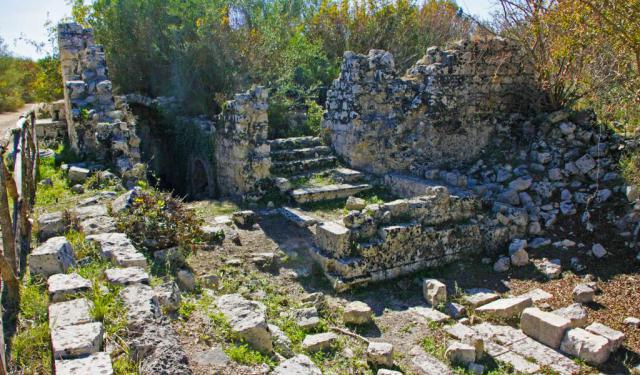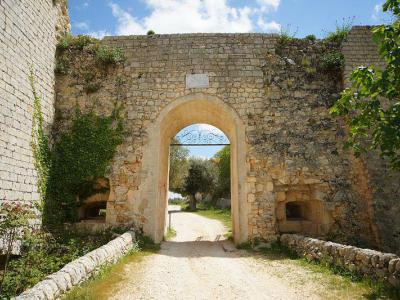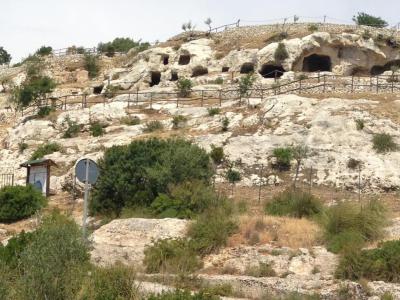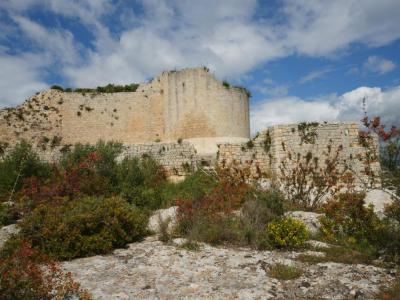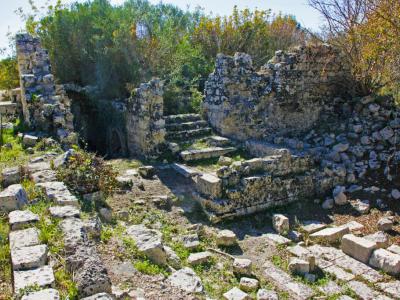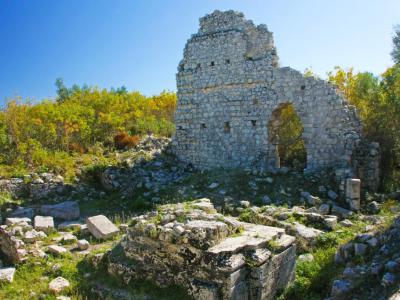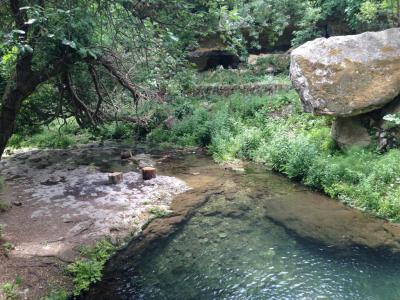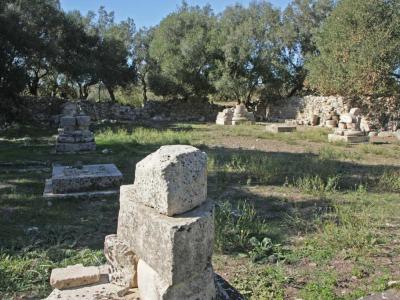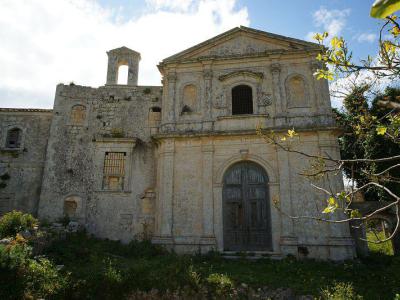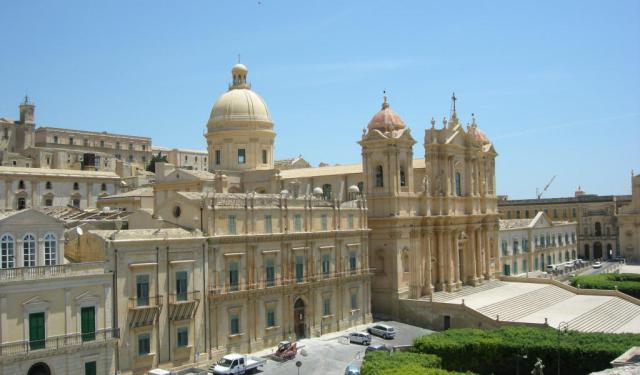Archaeological Park of Ancient Noto Tour (Self Guided), Noto
The Archaeological Park of Ancient Noto encompasses several archaeological areas that broadly include Ancient Noto (Noto Antica) in the south and Necropolis in the North. The former area, especially on the side of of the Mountain Gate (Porta della Montagna), an imposing structure serving as an entrance to this historical city, is bounded by the imposing 16th-century walls that withstood destructive earthquakes in 1693. This archaeological site is not guarded, admission is free, and you can enter it at any time of the day.
One of the park's standout features is The Memory Hill (La Collina della Memoria), providing panoramic views of the surrounding landscape. It puts visitors in a serene and contemplative atmosphere.
The Royal Castle of Don Pietro of Aragon (Castello Reale di Don Pietro d'Aragona) is a striking edifice within the park. A showcase of the medieval era architectural prowess, it offers a glimpse into the royal history of Sicily.
Landolina of Belludia Palace (Palazzo Landolina di Belludia), the remnant of a grand palace, is another jewel within the park. A vague reminder of the elegant architecture it once was.
The park also houses the Jesuit Church and College, the Carmine Church, and the Hermitage of Saint Mary of Providence (Eremo di Santa Maria della Provvidenza). These religious sites, or rather what's left of them now, offer insights into the spiritual and cultural aspects of the region.
Not to be missed is the Carosello Quarry (Cava Carosello), a testament to the region's geological history.
The Archaeological Park of Ancient Noto is a captivating historical location. As you explore it, prepare yourself to be transported to different periods of Sicilian history. We hereby invite you to take this self-guided walk and appreciate the cultural diversity and historical depth of the island firsthand.
One of the park's standout features is The Memory Hill (La Collina della Memoria), providing panoramic views of the surrounding landscape. It puts visitors in a serene and contemplative atmosphere.
The Royal Castle of Don Pietro of Aragon (Castello Reale di Don Pietro d'Aragona) is a striking edifice within the park. A showcase of the medieval era architectural prowess, it offers a glimpse into the royal history of Sicily.
Landolina of Belludia Palace (Palazzo Landolina di Belludia), the remnant of a grand palace, is another jewel within the park. A vague reminder of the elegant architecture it once was.
The park also houses the Jesuit Church and College, the Carmine Church, and the Hermitage of Saint Mary of Providence (Eremo di Santa Maria della Provvidenza). These religious sites, or rather what's left of them now, offer insights into the spiritual and cultural aspects of the region.
Not to be missed is the Carosello Quarry (Cava Carosello), a testament to the region's geological history.
The Archaeological Park of Ancient Noto is a captivating historical location. As you explore it, prepare yourself to be transported to different periods of Sicilian history. We hereby invite you to take this self-guided walk and appreciate the cultural diversity and historical depth of the island firsthand.
How it works: Download the app "GPSmyCity: Walks in 1K+ Cities" from Apple App Store or Google Play Store to your mobile phone or tablet. The app turns your mobile device into a personal tour guide and its built-in GPS navigation functions guide you from one tour stop to next. The app works offline, so no data plan is needed when traveling abroad.
Archaeological Park of Ancient Noto Tour Map
Guide Name: Archaeological Park of Ancient Noto Tour
Guide Location: Italy » Noto (See other walking tours in Noto)
Guide Type: Self-guided Walking Tour (Sightseeing)
# of Attractions: 8
Tour Duration: 2 Hour(s)
Travel Distance: 3.7 Km or 2.3 Miles
Author: DanaOffice
Sight(s) Featured in This Guide:
Guide Location: Italy » Noto (See other walking tours in Noto)
Guide Type: Self-guided Walking Tour (Sightseeing)
# of Attractions: 8
Tour Duration: 2 Hour(s)
Travel Distance: 3.7 Km or 2.3 Miles
Author: DanaOffice
Sight(s) Featured in This Guide:
- Ancient Noto and Gate of the Mountain
- La Collina della Memoria (The Memory Hill)
- Castello Reale di Don Pietro d'Aragona (Royal Castle of Don Pietro of Aragon)
- Palazzo Landolina di Belludia (Landolina of Belludia Palace)
- Chiesa e Collegio dei Gesuiti (Jesuit Church and College)
- Cava Carosello (Carosello Quarry)
- Chiesa del Carmine (Carmine Church)
- Eremo di Santa Maria della Provvidenza (Hermitage of Saint Mary of Providence)
1) Ancient Noto and Gate of the Mountain
In 1692, a devastating earthquake struck, wreaking havoc and destruction upon the ancient city of Noto. Rather than embarking on the laborious task of rebuilding the fallen city, a decision was made to establish a new one, located approximately ten kilometers away. This new city is now recognized as the Baroque gem of Noto, a UNESCO World Heritage site. However, nearly four centuries later, Ancient Noto, nestled atop a hilly outcrop nearby, remains concealed beneath the earth's embrace. It has earned the moniker "the Pompei of Sicily," as its remnants lie buried beneath layers of rubble, rock, and overgrown vegetation.
Despite the passage of centuries, it is still possible to explore the tranquil and evocative remnants of Ancient Noto. Its meager ruins have stirred the imaginations of writers, artists, photographers, and those seeking solace in its historical echoes. For those inclined to embark on a journey through history, Ancient Noto offers hiking opportunities, providing a sense of connection to the past and a serene escape from modern life.
One of the notable features of Ancient Noto is the Gate of the Mountain. This historic gate serves as the entry point to Monte Alveria and, like the city itself, stands as a testament to the enduring spirit of the past, as it has remained remarkably well-preserved through the ages.
The most convenient entry point was through the mountain gate's isthmus, where the formidable city fortifications remain prominently on display. Upon entering the park, you will proceed beneath the arch of this age-old gateway. Along the walls, you can still discern the vestiges of ancient embrasures and openings that once served the defenders. In proximity to the fortifications of the gate, remnants of chambers can still be found, likely utilized for storage and as guard quarters. Furthermore, a staircase has been preserved, providing access to the bastion for those who wish to take in the panoramic view from its vantage point.
Despite the passage of centuries, it is still possible to explore the tranquil and evocative remnants of Ancient Noto. Its meager ruins have stirred the imaginations of writers, artists, photographers, and those seeking solace in its historical echoes. For those inclined to embark on a journey through history, Ancient Noto offers hiking opportunities, providing a sense of connection to the past and a serene escape from modern life.
One of the notable features of Ancient Noto is the Gate of the Mountain. This historic gate serves as the entry point to Monte Alveria and, like the city itself, stands as a testament to the enduring spirit of the past, as it has remained remarkably well-preserved through the ages.
The most convenient entry point was through the mountain gate's isthmus, where the formidable city fortifications remain prominently on display. Upon entering the park, you will proceed beneath the arch of this age-old gateway. Along the walls, you can still discern the vestiges of ancient embrasures and openings that once served the defenders. In proximity to the fortifications of the gate, remnants of chambers can still be found, likely utilized for storage and as guard quarters. Furthermore, a staircase has been preserved, providing access to the bastion for those who wish to take in the panoramic view from its vantage point.
2) La Collina della Memoria (The Memory Hill)
The Memory Hill serves as the poignant repository of history, housing a vast collection of tombs that have been meticulously excavated from the rocky cliffs overlooking the Cava del Salitello. This site, known to archaeologists as the "Northern Necropolis," stands as a testament to the enduring passage of time and the complex history of ancient Noto, spanning over three millennia, from prehistory to the Middle Ages.
The tombs found within the Memory Hill represent various historical periods, offering a compelling glimpse into the multifaceted history of ancient Noto.
The tombs found within the Memory Hill represent various historical periods, offering a compelling glimpse into the multifaceted history of ancient Noto.
3) Castello Reale di Don Pietro d'Aragona (Royal Castle of Don Pietro of Aragon)
Royal Castle of Don Pietro of Aragon, also known as Noto Castle, is a historic fortress situated in the Ancient Noto.
The origins of Castello di Noto date back to the year 1431 when it was constructed by the Duke of Noto, Don Pietro d'Aragona. Don Pietro, a brother of King Alfonso V the Magnanimous, held the title of feudal lord over the town and its surrounding territories. The castle features a Main Tower that commands attention and stands as a symbol of the region's historical significance.
Beneath the castle, visitors have the opportunity to explore a Christian-Byzantine catacomb that dates back to the 6th and 7th centuries. This catacomb, with its arcosoli and rock-cut chambers, provides valuable insights into the religious and funerary practices of the time. Adjacent to the catacomb, on the right, lies a Greek-Classical tomb that bears witness to the ancient history of the region.
The site where Noto Castle is located has a storied past, with layers of history that span various civilizations. Originally, it served as a refuge for local tribes, who retreated to this rocky spur known as Mount Alveria. The natural defenses provided by deep ravines on either side made it an ideal location for settlement. Over the centuries, the area was inhabited by the Greeks, Romans, Byzantines, and Muslims, each leaving their mark on this historically significant region.
The origins of Castello di Noto date back to the year 1431 when it was constructed by the Duke of Noto, Don Pietro d'Aragona. Don Pietro, a brother of King Alfonso V the Magnanimous, held the title of feudal lord over the town and its surrounding territories. The castle features a Main Tower that commands attention and stands as a symbol of the region's historical significance.
Beneath the castle, visitors have the opportunity to explore a Christian-Byzantine catacomb that dates back to the 6th and 7th centuries. This catacomb, with its arcosoli and rock-cut chambers, provides valuable insights into the religious and funerary practices of the time. Adjacent to the catacomb, on the right, lies a Greek-Classical tomb that bears witness to the ancient history of the region.
The site where Noto Castle is located has a storied past, with layers of history that span various civilizations. Originally, it served as a refuge for local tribes, who retreated to this rocky spur known as Mount Alveria. The natural defenses provided by deep ravines on either side made it an ideal location for settlement. Over the centuries, the area was inhabited by the Greeks, Romans, Byzantines, and Muslims, each leaving their mark on this historically significant region.
4) Palazzo Landolina di Belludia (Landolina of Belludia Palace)
Landolina of Belludia Palace, despite its current state of very scant remains, stands as a testament to the grandeur and opulence of noble residences in the Ancient Noto. This magnificent palace, constructed at the outset of the seventeenth century, was renowned for its splendor and architectural beauty. However, the devastating earthquake of 1693 wrought total destruction upon the palace, reducing it to rubble.
Despite the tragic loss, subsequent excavations have revealed partial yet significant architectural remnants of Landolina of Belludia Palace. Among the uncovered fragments are remnants of grand stairways, arches, and corridors, which provide glimpses into the palace's former magnificence. These findings, when considered in relation to other ruins in the city, offer insight into the opulent and lavish character of the building that once graced Noto.
While the palace may now only exist in fragments, its memory lives on as a testament to the grandeur and history of Noto.
Despite the tragic loss, subsequent excavations have revealed partial yet significant architectural remnants of Landolina of Belludia Palace. Among the uncovered fragments are remnants of grand stairways, arches, and corridors, which provide glimpses into the palace's former magnificence. These findings, when considered in relation to other ruins in the city, offer insight into the opulent and lavish character of the building that once graced Noto.
While the palace may now only exist in fragments, its memory lives on as a testament to the grandeur and history of Noto.
5) Chiesa e Collegio dei Gesuiti (Jesuit Church and College)
Directly across from Palazzo Belludia, the remnants of the church and Jesuit college can be found, strategically positioned in the heart of the city. As you stand here today, near a pathway fork marked by a small commemorative shrine, it's worth noting that in the 17th century, this square served as the city's principal square. The Jesuit complex, an architectural gem initiated in 1606 and constructed in the Baroque style, was the work of Jesuit architect Natale Masuccio da Malta.
Tragically, like the rest of Noto, the church of the Jesuit Order in the ancient city fell victim to the earthquake that ravaged the eastern part of Sicily in 1693. Recent research efforts have shed light on the complex history of this edifice, even allowing for the creation of a 3D model depicting a hypothetical reconstruction of the complete church.
Through the examination of surveys and historical records, it has been determined that the church remained unfinished at the time of the earthquake. Furthermore, the layout of the ruins does not align with the known architectural drawings from the first half of the 17th century. An analysis of the ruins indicates that the Jesuits of Noto had envisioned the construction of a monumental church, necessitating the demolition of a portion of an existing structure to make way for the new edifice.
Tragically, like the rest of Noto, the church of the Jesuit Order in the ancient city fell victim to the earthquake that ravaged the eastern part of Sicily in 1693. Recent research efforts have shed light on the complex history of this edifice, even allowing for the creation of a 3D model depicting a hypothetical reconstruction of the complete church.
Through the examination of surveys and historical records, it has been determined that the church remained unfinished at the time of the earthquake. Furthermore, the layout of the ruins does not align with the known architectural drawings from the first half of the 17th century. An analysis of the ruins indicates that the Jesuits of Noto had envisioned the construction of a monumental church, necessitating the demolition of a portion of an existing structure to make way for the new edifice.
6) Cava Carosello (Carosello Quarry)
For those seeking adventure, a communion with nature, and moderately challenging hikes, the Carosello Quarry beckons. Here, amidst serene lakes and meandering streams, ancient caves have been repurposed into rock tanneries. The breathtaking quarry boasts over 50 ancient rock tanneries that have been active since the 1400s.
This site is also a haven of remarkable biodiversity. Here, you'll be serenaded by the melodious tunes of blackbirds, the gentle rush of water, and the fragrant aroma of lesser calaminth. During the summer months, you can even take a refreshing swim and unwind by one of the small lakes formed by the Asinaro River.
This site is also a haven of remarkable biodiversity. Here, you'll be serenaded by the melodious tunes of blackbirds, the gentle rush of water, and the fragrant aroma of lesser calaminth. During the summer months, you can even take a refreshing swim and unwind by one of the small lakes formed by the Asinaro River.
7) Chiesa del Carmine (Carmine Church)
The Church of Carmine in Noto Antica, dating back to the early 1600s and built atop an earlier church, now stands mostly in ruins. Its outer walls have deteriorated over time, but remnants of columns provide a glimpse into its original structure. Within the church, the presence of two rows of columns reveals its three-nave design.
Additionally, the site offers insights into the history of the Carmelite friars, as tombs and well-preserved tombstones suggest that a portion of the church was used for their burials. Notably, visitors can still discern the outlines of these tombs, featuring bas-reliefs depicting crossed bones-an intriguing testament to the church's past.
Additionally, the site offers insights into the history of the Carmelite friars, as tombs and well-preserved tombstones suggest that a portion of the church was used for their burials. Notably, visitors can still discern the outlines of these tombs, featuring bas-reliefs depicting crossed bones-an intriguing testament to the church's past.
8) Eremo di Santa Maria della Provvidenza (Hermitage of Saint Mary of Providence)
The Hermitage of Saint Mary of Providence, located in the southern outskirts of Noto Antica, stands as a historical and spiritual site of significance. This hermitage and church were constructed in 1723, atop the ruins of a prior hermitage that had succumbed to the destructive force of an earthquake. Originally, the hermitage was occupied by the Carmelite Sisters, who diligently managed its affairs until 1800 when the structure was left abandoned.
Today, the complex exists in a state of graceful decay, bearing witness to the passage of time and the ravages of history. Despite the wear and tear, both the convent and the church within the hermitage have been carefully preserved. Within the church, where the effects of time and occasional acts of vandalism are apparent, one can still admire the elegant stuccoes and paintings adorning the vaulted ceilings.
The facade of the church itself is a striking example of Baroque architecture, characterized by its ornate and intricate design.
Today, the complex exists in a state of graceful decay, bearing witness to the passage of time and the ravages of history. Despite the wear and tear, both the convent and the church within the hermitage have been carefully preserved. Within the church, where the effects of time and occasional acts of vandalism are apparent, one can still admire the elegant stuccoes and paintings adorning the vaulted ceilings.
The facade of the church itself is a striking example of Baroque architecture, characterized by its ornate and intricate design.
Walking Tours in Noto, Italy
Create Your Own Walk in Noto
Creating your own self-guided walk in Noto is easy and fun. Choose the city attractions that you want to see and a walk route map will be created just for you. You can even set your hotel as the start point of the walk.
Noto Introduction Walking Tour
Perched high on a plateau with a panoramic view of the Asinaro Valley, in the shadow of Mount Alveria, the city of Noto is renowned as the Baroque capital of Sicily.
The name "Noto" finds its roots in the ancient Greek word "Neaton," which is likely translated to "south". Later, it was Romanized as "Netum." The Romans granted this territory to Hiero II... view more
Tour Duration: 1 Hour(s)
Travel Distance: 0.9 Km or 0.6 Miles
The name "Noto" finds its roots in the ancient Greek word "Neaton," which is likely translated to "south". Later, it was Romanized as "Netum." The Romans granted this territory to Hiero II... view more
Tour Duration: 1 Hour(s)
Travel Distance: 0.9 Km or 0.6 Miles
The Most Popular Cities
/ view all
